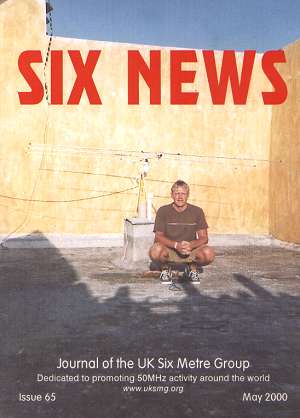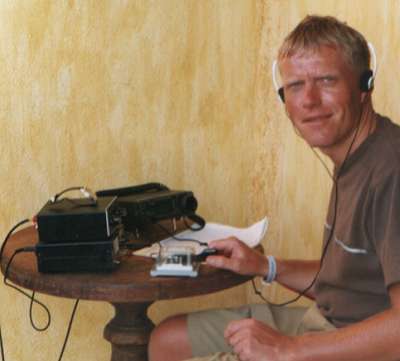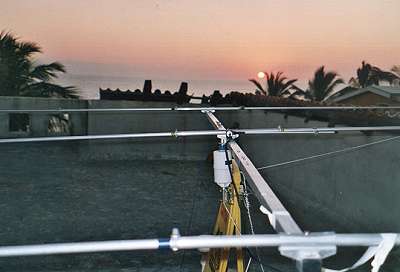Introduction
Some 18 months ago I decided, along with my wife, Cathy to spend the Millennium well away from the UK. While researching a number of destinations I always had it in the back of my mind to choose somewhere I might be able to obtain a six-metre licence and experience being ‘DX’ instead of always chasing it!
In the end we settled for a location on the pacific coast of Mexico in the Bay of Banderas. The nearest village was called Bucerias (Nayrit State), about 30km north of Puerto Vallarta and –7 hours GMT. The grid locator was DL70JK.
The licence
I’d been told by a number of people while researching six-metre licensing around the world that it was possible but ‘not easy’ to get the necessary paperwork in advance from Mexico. I was advised it was a little easier to get documents in person but the nearest ‘local’ office to where I was staying was a 16-hour round trip by car, something I didn’t particularly fancy.
 The man himself with the 3-element beam on the roof of the hotel.
The man himself with the 3-element beam on the roof of the hotel.
In February 1999 I located a internet site which specialised in providing links to relevant PTT sites and local contacts for further assistance. I soon established e-mail contact with Memo XE1NJ, secretary of the local federation, who kindly helped me through the early stages of my application.
Part of the application required obtaining a visa to cover the period of operation. After contacting the Mexican Embassy in London, I was told this was not a requirement for UK Citizens and I could not have one! Maybe I didn’t need one for my licence then? I contacted Memo, XE1NJ again and he replied ‘no visa no licence’. The next two-three weeks were spent trying to explain to a very friendly lady at the embassy that although I appreciated I didn’t need a visa to enter the country, I still wanted one. Eventually mid-March arrived and so did my visa. By April I had all the paper work to fax to Mexico City, including a copy of my UK Licence, passport, visa and application form (from the Mexican PTT web site).
The application form stated that I should not send anything to the PTT more than six months in advance, so at the end of June my application was faxed. I requested a return confirmation and final bank transfer payment details. It was time to sit back and wait.
By early August, I’d heard nothing so contacted Andy, XE1/G3SVD who was living near Mexico City at the time. Andy kindly offered to call the PTT for an update, "Good news" came the reply - my application had been received and I should hear something soon.
September arrived but still nothing. Andy called again on my behalf, this time the reply came: "We remember it arriving but can’t find it now"!!
On September 5th 1999 I started again and re-faxed all the documents to Mexico. Memo, XE1NJ confirmed they were in the hands of the correct official and it would be processed that day, I should hear something very soon. October arrived and still no direct contact from Mexico City, Andy was back in the UK and Memo was no longer replying to my e-mails (maybe I’d exhausted his services by now!). I was pondering what to do next.
A few days later I saw an e-mail on the Pacific Rim Reflector from Lasse, XE1/SM0KAK. I took the opportunity to mail him explaining my predicament. The following day Lasse contacted the PTT and discovered my licence had been sent out but to the address I was going to operate from in Mexico. This was something of a surprise as I’d specifically requested it to be sent to my UK address!
Lasse kindly got his wife to call at the PTT the next day and get another copy, which was faxed to me at work. I faxed it on to the DXCC desk, who confirmed by e-mail on November 1st that XE1/GØJHC had been added to their database and was good for DXCC.
Nine months after starting out I finally had the paperwork in place. Without the assistance of XE1NJ, G3SVD and SM0KAK it would have been very difficult to obtain in advance.
The last job to do was fax the hotel and advise them of our arrival dates and what we would like to do. A big "thank you" to Jose, EA7KW for writing quite a long letter in Spanish on our behalf.
Getting there and on the air
Travelling with us were Lee, GØULN and his wife Elaine. Lee planned on a bit of HF activity and was taking with him an ICOM 706 and wire antennas. Arrival in Mexico was on December 21stt after a 15-hour flight. Gatwick checkin didn’t seemed concerned about 8kg of excess baggage and we were on our way.
Mexican Customs have an interesting system which has everyone in a line pressing a button, which triggers a set of traffic lights; if it shows green you walk through, if it shows red you empty your bags. A gentleman before me got a red, so our party was relived to go straight through on green.
For some reason I had imagined on the outward journey that on arrival at hotel reception, they would have my original licence waiting, allocate me a top floor room and ask me when I wanted help erecting antennas. Unfortunately it didn’t quite work out like that.
 XE1/GØJHC
operating on Six from his hotel balcony on the Bay of Banderas.
XE1/GØJHC
operating on Six from his hotel balcony on the Bay of Banderas.
No one seemed to have any knowledge of the fax I’d sent the week earlier, or had seen the original licence the PTT had sent to the hotel. In fact they hadn’t a clue what I was taking about!
We were told to come back and speak with the Manager the following morning. Early on the 22nd equipment was unpacked, a very quick and easy task on the balcony of our apartment. I had taken the Icom 706 II, memory keyer and a Zepp tuned for 28885, this was all powered through the clip-on 240/110v PSU from the back of an FT650. The 50MHz antenna was a three-element tapered beam; all the elements slid inside the boom, which broke down to one-metre sections and fit inside my case.
The next 3-4 days were nothing short of a farce. In order to get on to the roof we met with hotel management to introduce ourselves and advise of our needs. Nothing was ever straightforward: we could go on the roof, but we had to be accompanied by hotel maintenance at all times. Hotel maintenance never turned up when a time had been arranged and management seemed powerless (or unwilling) to push. In fact it soon became clear that such phrases as "come back in one hour" and "no problem" actually translated into "come back tomorrow – its my day off" and "no chance".
On December 24th we decided to have a look on the roof ourselves. We found a roof gate unlocked and quickly we started to erect the wires and six-metre beam, hopefully unnoticed. Two hours later things were finished and we could check six metres. The 50MHz SWR was high and the rotator was playing up, so I returned to try and resolve the problem. To my surprise the gate we had used a few minutes earlier had now been padlocked and I couldn’t get back up! That evening I erected a 6m dipole across the balcony and just listened to noise.
The following day we discovered maintenance had locked the roof access and remained unwilling to assist. I was now stuck with no way of getting to the beam to SWR it, and as it stood it was useless. The next few days I listened only on the dipole, often hearing the ZL video offsets of 45240 250 and 260kHz, but never any stations. Daily contact on 28885 with Ray ZL2KT suggested things were dead anyway, so I got on with my holiday instead.
Improved conditions
Towards the end of my first week, conditions began to pick up. December 29th saw ZL2KT at 41 for a few seconds on SSB. On December 31st at 2327z (4.30pm local) my CW CQ was answered by Frank ZL2AGI and I’d finally made a QSO. I understand from DXcluster reports that VK2QF heard me for a few seconds during this QSO - I was still using the dipole about 3 feet above my head!
 Neil's
antenna on the flat roof at 20m AGL/ASL and 30m from the shore, as the sun was
setting over the ocean (peak propagation time) beaming ZL/VK.
Neil's
antenna on the flat roof at 20m AGL/ASL and 30m from the shore, as the sun was
setting over the ocean (peak propagation time) beaming ZL/VK.
This QSO spurred me on to try and get back to the beam (I won’t bore you with the daily fights I was having with the hotel’s representative at ‘guest relations’ by this point).
Later on December 31st, once it had gone dark, I got back onto the roof by climbing over a ledge and jumping across a roof. I quickly dismantled the beam and brought it back down to the apartment. During the week I had discovered another split-level roof, one which I could access from a top staircase. This one was very convenient: I only needed 12m of coax to get back to the balcony, it was very much ‘open plan’ making it impossible for my access to be barred and I could also work on it undetected.
This allowed me to tune the antenna to 1:1 and gave over the horizon views across the Pacific. There was the disadvantage with this roof that one direction was blocked by a wall (South America) but neither of the two XE six-metre beacons had been copied for some weeks in South America and LU2EG advised that the N/S path was falling short in the eastern Caribbean. So I decided to forgo this direction in order to get the beam working into the Pacific.
New Year
The New Year arrived, and hopefully better conditions. 22-02 GMT (3pm-7pm local) I was advised would be the best times to check the band for ZL/VK. Around 2130 GMT I arrived on the balcony; the video carriers were strong and 50.750 Audio was 59. A few calls on 50.110 brought nothing, then all of a sudden "bang!" ZL2KT was 59 on SSB; we quickly worked at 2147z, then went to FM for an end-stop QSO.
Three hours later I went out for dinner with the band still wide open but no one new to work. I’d logged 23 different ZL calls on six metres in eight grids on both North and South Islands, plus Jerry, VK7GF. Finally some reward!
January 2nd was a strange day, with weak ZLs. I left the CQ machine calling while having a siesta: VK3OT broke the keyer at 2250 at a QRB of 13400km - things were getting better. Steve’s signals remained audible for a further two hours; VK3BWT was worked on SSB too.
January 3rd – January 12th took on a very similar pattern, with signals from ZL appearing every day apart from the 7th, signals were usually between 55-57. The window had a defined peak around 23-01GMT. VK3OT was worked again, this time with 599 signals, on January 5th, along with three more VK3s. I understand that the ZLs had sporadic-E to VK3 at the time, so I guess it was some sort of Es extended link up.
Observations
I would like to share two major observations regarding New Zealand propagation. The first relates to the video signals at 45MHz. On a number of occasions these were all very strong, but 50MHz remained dead and on other occasions 50MHz was wide open and the videos were almost non existent. By far the most reliable indication that six metres would have amateur signals soon was the 50.750 audio - there were no occasions when this was copied (above S5) and I didn’t have ZLs on Six.
If your game is chasing six-metre DX, life doesn’t come much harder than being a ZL – but I was surprised at the level of activity. Most run very modest stations, due to being plagued by EMC problems. Out of the 30 or so fairly active ZLs (info from ZL2AGI), I managed to work 25, and at least two were out of the country at the time. But I was surprised by the lack of CW activity; only two stations in three weeks answered my CW calls; the impression I got was that most don’t bother with the mode.
So if you want to increase your chances of working ZL from Europe, watch for 50.750 and stick with SSB!
Summing up
By the end of my trip I’d worked 25 different ZL calls and 7 different VKs, plus XE1/SM0OUG and N6XQ, both on scatter. A total of six fields and 15 grids, 34 stations in all. Ray, ZL2KT and Frank, ZL2AGI were heard (between them) on 12 consecutive days. Away from the weekends only Ray and Frank appeared on the band since most of the others work during the day.
Conditions remained stable for hours over the 10,000km+ path, but it did become frustrating with so few stations QRV. Some days I would meet Ray, ZL2KT on Six and get him to access the web address of my local newspaper. He then read back the main articles and football scores etc, that’s how good the path was! I didn’t hear any signals from anywhere else. 28885 seemed very quiet during my stay, but a special thank you to Ray and Jim K6MIO/KH6 for the daily schedules and updates.
All in all I’d say it was a success, although with a crystal ball I’d probably have been happy to go without radio and all the hassle which accompanied me on this trip. The hotel was a great place to stay, but most certainly radio amateur unfriendly. I’d recommend a visit to Mexico, but go prepared to accept that most things won’t happen in hurry - and some things just wont happen at all!